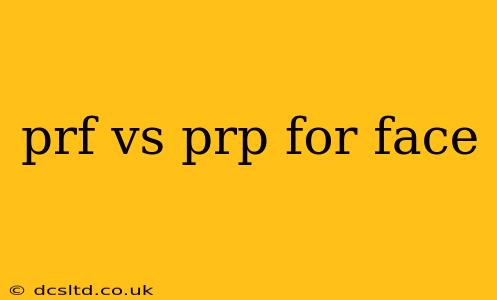Choosing between platelet-rich fibrin (PRF) and platelet-rich plasma (PRP) for facial rejuvenation can feel overwhelming. Both treatments harness the power of your own blood to stimulate collagen production and promote tissue regeneration, leading to a more youthful appearance. However, subtle yet significant differences exist in their preparation, application, and resulting effects. This comprehensive guide will delve into the nuances of PRF vs. PRP for the face, helping you make an informed decision.
What is Platelet-Rich Fibrin (PRF)?
PRF is a second-generation platelet concentrate derived from your own blood. Unlike PRP, PRF doesn't require any additives or activating agents. The blood is spun in a centrifuge at a lower speed for a shorter duration, resulting in a fibrin-rich matrix that contains concentrated platelets, growth factors, and white blood cells. This natural fibrin clot acts as a scaffold, slowly releasing growth factors over an extended period. This prolonged release contributes to its sustained regenerative properties.
What is Platelet-Rich Plasma (PRP)?
PRP, a more established treatment, also uses your own blood. However, it typically involves adding an activator (like calcium chloride) to the blood sample before centrifugation. This speeds up the clotting process, resulting in a higher concentration of platelets in a smaller volume of plasma. While effective, the addition of activators may alter the natural composition and potentially reduce the longevity of growth factor release compared to PRF.
PRF vs. PRP: Key Differences
| Feature | PRF | PRP |
|---|---|---|
| Preparation | Centrifugation only; no additives | Centrifugation with activators added |
| Platelet Count | Lower concentration | Higher concentration |
| Growth Factor Release | Gradual and prolonged | Faster, but potentially shorter-lived |
| Fibrin Matrix | Abundant, acts as a scaffold | Less abundant |
| Cost | Can vary, but often slightly more expensive than PRP | Generally less expensive than PRF |
How are PRF and PRP used for Facial Rejuvenation?
Both PRF and PRP can be used to address various facial concerns, including:
- Fine lines and wrinkles: Stimulating collagen production helps to reduce the appearance of wrinkles.
- Skin texture improvement: They can improve skin tone, making it smoother and more even.
- Acne scars: The growth factors promote tissue repair, leading to a reduction in scar visibility.
- Hair loss: While primarily used for facial rejuvenation, both can be injected into the scalp to stimulate hair growth.
Which Treatment is Right for Me? PRF or PRP?
The choice between PRF and PRP depends on individual needs and preferences, as well as physician expertise. A consultation with a qualified medical professional is essential to determine the best approach. Factors to consider include:
- Severity of concerns: For more severe wrinkles or significant scarring, PRP might provide a quicker, more visible initial improvement, though the effects may not be as long-lasting as PRF.
- Desired longevity of results: PRF, with its sustained growth factor release, may offer more lasting effects, although visible results might take a bit longer to appear.
- Individual response: The effectiveness of both treatments can vary depending on individual factors.
What are the Potential Side Effects of PRF and PRP?
Both PRF and PRP are generally considered safe procedures with minimal side effects. However, potential side effects may include:
- Mild swelling or bruising: This is common and typically resolves within a few days.
- Injection site discomfort: Some tenderness or pain at the injection sites is possible.
- Infection (rare): Maintaining proper hygiene and following post-procedure instructions is crucial to minimize this risk.
How Long Do the Results Last?
The duration of results varies depending on the individual, the treatment area, and the specific concerns being addressed. Generally, you can expect to see gradual improvements over several weeks, with results lasting several months to a year or longer, potentially requiring maintenance treatments.
Are PRF and PRP Covered by Insurance?
Insurance coverage for PRF and PRP facial rejuvenation varies widely and depends on individual insurance plans and the reason for the treatment. It is best to check with your insurance provider directly to understand your coverage.
Are there Alternatives to PRF and PRP?
Yes, several other treatments can address similar concerns, such as fillers, Botox, laser treatments, and chemical peels. Your physician can discuss these options and help you choose the best approach based on your individual needs and goals.
This information is for educational purposes only and should not be considered medical advice. Always consult a qualified healthcare professional before making any decisions about your treatment.
